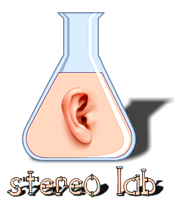

Clicking on the left-hand General tab opens a dialogue page incorporating fields where the user is offered the choice to include the file extensions, and the option to include the full path address for source files. This page also incorporates the setting for the clipping overload warning. The overload warning pops up when the file conversion produces results which exceed maximum digital value (0dBFS) by a margin determined by the value set here. By default this value is 2dB; a good choice for general use. However recording and mastering engineers may want to set this much lower; perhaps +0.1dBFS. For more information on overloads caused in this software see here.
Also included on this, first, tab are the parameter adjustments for Loudness processing.

The middle (Settings) tab opens a dialogue in which various processing parameters may be altered. These include options for automatic Hi-Res processing and for Dither. Also included here are the settings for the Groove algorithm and for Ambisonics decode options.
Groove parameters
The Groove algorithm incorporates some user-selectable parameters and these are exposed on the user-interface via two sliders. The first of these controls the amount of harmonic distortion added to the upconverted signal. The distortion is predominantly second harmonic and the range is quite small. With the fader in the default (central) position, the degree of distortion added is typical of that produced by a high-quality, new LP record when it traces the outer grooves of a 12" disc. Sliding the fader to the right adds more distortion. The subjective effect of adding more distortion is just that....., subjective! Some feel this adds "warmth", others perceive this as a "roughness". When the slider is moved to the left, less distortion is added. At the extreme left-hand end of the travel no non-linearity is present.
The second slider controls the degree of simulated groove noise which is added to the signal. Once again, with the slider in the central position, the amount of noise is similar to that measured from a brand-new, 180 gram LP. The default setting causes noise to peak to approximately -50dB below 0dBFS. This may sound quite high, but the spectrum on the noise falls sharply with frequency, so its subjective effect is less than the -50dBFS figure might suggest. The noise is generated mathematically and shaped in a digital noise-shaping filter. There is no attempt to generate "clicks and pops" since these are regarded as a non-desirable feature of LP replay.
Note that the noise is not removed altogether when the slider is at its left-hand end-stop (as is the case with the distortion control). Instead the noise peaks to approximately -70dBFS.
Ambisonics UHJ options
The Ambisonics options relate to the optimisation of the spatial signal according to loudspeaker configuration and arrangement. The various options are explained here.
This tab allows the various decoding options for CD-4 quadraphonic LPs.
 Home page
Home page
For all support issues, go here.
For Pspatial Audio sales, email: sales@pspatialaudio.com
